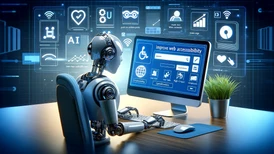Accessibility in an AI-powered world
With the help of AI, accessibility on websites and web apps can be improved. Ahmet lists 5 exciting AI solutions for accessibility adaptations in the tech industry.

Now that more and more AI-related solutions are starting to see the light of day, as a front-end developer with a focus on accessibility, I think about how I can improve things and develop solutions with the help of AI in a way that I couldn't before.
From an accessibility perspective, there are a number of AI solutions that are already improving the web for people with disabilities. Here I list my top five reconnaissances that I think will play a significant role, especially in relation to the new accessibility directive that comes into force in June 2025.
1. Automatic image captioning
We have already seen how to use AI to generate alt texts for images that the AI loads, this aims to make images accessible to all users, especially those who are visually impaired or blind. When image uploading and image management have become a part of everyday life through social media, we can see that automatic image captioning is a big plus for all visually impaired people. This is done through machine learning and a so-called computer vision that allows AI models to be trained to then recognize the image, and quickly spit out a text, based on what is identified. This is something we at Epinova already use and have available in our own Epinova AI Assistant.
2. Improved screen readers
Using AI, screen readers can translate and read complex elements such as charts and provide the user with real-time information. Many of today's websites contain more dynamic content than they did a few years ago. This is where AI can come in as a good help. By notifying when important updates occur, in real time, without having to disturb the user with more information. Source: JAWS picture smart AI
3. Real-time translations for videos and media
Something that Google translate is already doing and that can be found in some parts of Youtube. With the help of AI, you can pick up the voice of a video and translate it into the language of your choice. This is not fully functional yet but is definitely something to look forward to. This feature can help visitors who are watching videos on a website and may want a language other than the default language used in the video. Source: Google translate AI
4. Improved sign language interpretation
Here, too, AI can come in as a great help for those who are deaf or hard of hearing. I believe being able to translate sign language into speech and text as a great benefit in the world of accessibility and can contribute to a whole new audience of users/visitors to your website. Especially also if you can turn it around and make it possible to convert speech and text into sign language.
5. Text and communication aids
There are already a number of AI tools that generate text for you. What I see in the future is that this will also be developed more to make the text more readable and, for example, adapt texts for people with dyslexia or some other form of difficult reading comprehension.
Summary
As a developer, I look forward to implementing different AI solutions so that I can make the web extra accessible to everyone with the help of AI. It should be easy to get through websites and web apps, and to absorb information, regardless of disability. I am convinced that with the help of AI, we can make tomorrow's digital solutions even more accessible to everyone.
The image is generated in PhotoShop using AI.
If you want to know more or have thoughts, feel free to write a comment!

We would like to hear what you think about the blog post